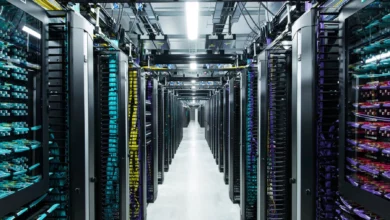Demystifying Data Center Switches: Understanding How They Work and Comparing Switch Stacking, Trunking, and Uplink for Enhanced Connectivity

Introduction
Data centers are the digital hubs of the modern world, housing and processing vast amounts of data. At the core of these data centers are data center switches, a critical component that plays a vital role in ensuring the seamless flow of data. In this article, we will demystify data center switches, delve into their operations, and compare three essential methods for enhancing connectivity: switch stacking, trunking, and uplink technology.
A data center switch, also known as a network switch or Ethernet switch, is a fundamental device used to interconnect multiple devices within a local area network (LAN) or data center. These switches operate at both Layer 2 (data link layer) and Layer 3 (network layer) of the OSI model, facilitating the efficient transfer of data.
Understanding the Basics: How Does a Switch Function in a Data Center Network?
To comprehend the significance of data center switches, it’s essential to grasp how they function within a network. These are the key aspects of switch operation:
Data Forwarding Process: When a switch receives data packets, it examines the destination MAC (Media Access Control) address of each packet. Using this information, the switch determines which port to forward the packet to. This process is highly efficient and eliminates unnecessary network traffic.
MAC Address Table: Switches maintain a MAC address table, which contains information about the devices connected to each port. This table helps the switch determine the destination of incoming data packets.
VLANs: Virtual Local Area Networks (VLANs) allow switches to segment the network into smaller, isolated networks. This segmentation enhances security and optimizes network traffic by keeping unrelated devices separate.
The Power of Switch Stacking: Increasing Scalability and Simplifying Management
Switch stacking is a method of connecting multiple switches to create a unified system. These stackable switches work as a single unit, providing several benefits:
Simplified Management: Stacking switches streamline management, making it easier to configure and monitor multiple devices as a single entity. This reduces administrative complexity.
Scalability: As your data center grows, adding more stackable switches is straightforward. This scalability ensures your network infrastructure can expand with your needs.
Redundancy: Stacked switches can offer redundancy. If one switch fails, the others continue to operate, ensuring network availability.
Stackable switches are a cost-effective and space-efficient solution for businesses aiming to optimize their network infrastructure. However, it’s crucial to select stackable switches that meet your specific capacity and feature requirements.
Trunking for Improved Efficiency: Boosting Bandwidth and Streamlining Network Traffic
Trunking is a networking method used to aggregate multiple links between switches, optimizing bandwidth usage and improving network performance. Key components of trunking include:
VLAN Trunking Protocol (VTP): VTP enables switches to share VLAN configuration information. This feature is valuable for data centers that rely on VLAN segmentation.
Link Aggregation Control Protocol (LACP): LACP, also known as IEEE 802.3ad, allows switches to aggregate multiple links, creating a high-capacity logical connection. This technology enhances both bandwidth and fault tolerance.
Trunk Configuration: Setting up trunk links involves configuring ports to carry multiple VLANs. This optimizes network traffic and ensures efficient data transfer.
Trunking can significantly improve network performance, making it an excellent choice for data centers with high data throughput requirements. However, not all switches support trunking, so it’s crucial to verify compatibility before implementation.
Uplink Options for Enhanced Connectivity: Choosing the Right Uplink Technology for Your Data Center
Uplink connections play a pivotal role in ensuring data center connectivity. They serve as the links between your data center switches and other switches or network segments, typically connecting to core switches or routers. Different uplink options include:
Gigabit Ethernet Uplink: This standard uplink option offers a data rate of 1 gigabit per second (Gbps) and is suitable for many data center applications.
10 Gigabit Ethernet Uplink: For data centers with higher bandwidth demands, a 10 Gbps uplink connection provides the necessary speed for efficient data transfer.
Fiber Optic Uplink Options: Fiber optic uplinks are ideal for long-distance connections and environments where electromagnetic interference is a concern. They offer high bandwidth and low latency.
Comparing Switch Stacking vs Trunking vs Uplink: Which Option is Right for You?
Choosing the right method to enhance switch connectivity for your data center depends on several factors. Here’s a comparison of these options to help you make an informed decision:
Switch Stacking:
Pros: Simplified management, scalability, redundancy.
Cons: Limited to stackable switches, may not meet extremely high-capacity requirements.
Trunking:
Pros: Bandwidth optimization, improved performance, simplified management.
Cons: Not all switches support trunking, require careful configuration.
Uplink:
Pros: Redundancy, load balancing, scalability.
Cons: Requires additional hardware, which may be overkill for small-scale data centers.
Conclusion
Data center switches are the linchpin of efficient data flow and network connectivity in our digital age. By understanding how switches work and comparing the advantages of switch stacking, trunking, and uplink technologies, you can optimize your data center’s network infrastructure to meet your specific needs.
Consider factors such as capacity requirements, budget constraints, redundancy and high availability, and the technical expertise of your IT team when making your choice. With the right switch configuration, you can ensure that your data center operates seamlessly, meeting the demands of a digitally connected world.





